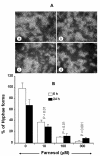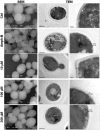Farnesol, a fungal quorum-sensing molecule triggers Candida albicans morphological changes by downregulating the expression of different secreted aspartyl proteinase genes
- PMID: 22207890
- PMCID: PMC3242405
- DOI: 10.2174/1874285801105010119
Farnesol, a fungal quorum-sensing molecule triggers Candida albicans morphological changes by downregulating the expression of different secreted aspartyl proteinase genes
Abstract
The aim of this study was to determine the effect of exogenous farnesol in yeast-to-hyphae morphogenesis, and Saps (2, 4, 5 and 6) mRNA expressions by a Candida strain that does not produce endogenous farnesol. C. albicans was cultured in the absence and presence of farnesol at various concentrations (10, 100, and 300 µM), in proteinase induction medium, and then used to determine yeast-to- hyphae changes, Candida ultrastructure and to determine Saps 2, 4, 5 and 6 expressions using q-TR-PCR and ELISA (for Sap2). Data demonstrated that farnesol greatly reduced the yeast-to-hyphae morphogenesis of a Candida strain that does not produce endogenous farnesol. Farnesol induced several ultrastructural alterations, including changes in the cell-wall shape, a visible disconnection between the cell wall and cytoplasm with an electron-lucent zone between them, and the presence of electron-dense vacuoles. Tested on gene expressions, farnesol was able to significantly (p < 0.01) decrease Sap2 secretion and mRNA expression. Farnesol downregulated also Sap4-6 mRNA expression. These results demonstrated for the first time that farnesol modules Candida morphogenesis through a downregulation of Saps 2, 4, 5 and 6 expressions. Overall these data point to the potential use of farnesol as an antifungal molecule.
Keywords: Candida; farnesol; saps.; transition.
Figures




Similar articles
-
Antimicrobial effect of farnesol, a Candida albicans quorum sensing molecule, on Paracoccidioides brasiliensis growth and morphogenesis.Ann Clin Microbiol Antimicrob. 2009 Apr 29;8:13. doi: 10.1186/1476-0711-8-13. Ann Clin Microbiol Antimicrob. 2009. PMID: 19402910 Free PMC article.
-
Effect of farnesol on Candida dubliniensis morphogenesis.Lett Appl Microbiol. 2007 Feb;44(2):199-205. doi: 10.1111/j.1472-765X.2006.02044.x. Lett Appl Microbiol. 2007. PMID: 17257261
-
Effects of farnesol and lyticase on the formation of Candida albicans biofilm.Vet World. 2020 Jun;13(6):1030-1036. doi: 10.14202/vetworld.2020.1030-1036. Epub 2020 Jun 8. Vet World. 2020. PMID: 32801551 Free PMC article.
-
Properties and role of the quorum sensing molecule farnesol in relation to the yeast Candida albicans.Pharmazie. 2017 Jun 1;72(6):307-312. doi: 10.1691/ph.2017.6174. Pharmazie. 2017. PMID: 29442016 Review.
-
Physiological adventures in Candida albicans: farnesol and ubiquinones.Microbiol Mol Biol Rev. 2024 Mar 27;88(1):e0008122. doi: 10.1128/mmbr.00081-22. Epub 2024 Mar 4. Microbiol Mol Biol Rev. 2024. PMID: 38436263 Free PMC article. Review.
Cited by
-
Sociomicrobiome of wood decay in a tropical rain forest: unraveling complexity.Springerplus. 2013 Sep 4;2:435. doi: 10.1186/2193-1801-2-435. eCollection 2013. Springerplus. 2013. PMID: 24052931 Free PMC article.
-
Cigarette smoke condensate increases C. albicans adhesion, growth, biofilm formation, and EAP1, HWP1 and SAP2 gene expression.BMC Microbiol. 2014 Mar 12;14:61. doi: 10.1186/1471-2180-14-61. BMC Microbiol. 2014. PMID: 24618025 Free PMC article.
-
The Role of Fatty Acid Metabolites in Vaginal Health and Disease: Application to Candidiasis.Front Microbiol. 2021 Jul 2;12:705779. doi: 10.3389/fmicb.2021.705779. eCollection 2021. Front Microbiol. 2021. PMID: 34276639 Free PMC article. Review.
-
Farnesol and Selected Nanoparticles (Silver, Gold, Copper, and Zinc Oxide) as Effective Agents Against Biofilms Formed by Pathogenic Microorganisms.Nanotechnol Sci Appl. 2024 Apr 16;17:107-125. doi: 10.2147/NSA.S457124. eCollection 2024. Nanotechnol Sci Appl. 2024. PMID: 38645468 Free PMC article.
-
Metabolome and Transcriptome Combinatory Profiling Reveals Fluconazole Resistance Mechanisms of Trichosporon asahii and the Role of Farnesol in Fluconazole Tolerance.Microorganisms. 2023 Nov 17;11(11):2798. doi: 10.3390/microorganisms11112798. Microorganisms. 2023. PMID: 38004810 Free PMC article.
References
-
- Wisplinghoff H, Bischoff T, Tallent SM, Seifert H, Wenzel RP, Edmond MB. Nosocomial bloodstream infections in US hospitals: analysis of 24,179 cases from a prospective nationwide surveillance study. Clin Infect Dis. 2004;39:309–17. - PubMed
-
- Marchetti O, Bille J, Fluckiger U, et al. Epidemiology of candidemia in Swiss tertiary care hospitals: secular trends 1991–2000. Clin Infect Dis. 2004;38:311–20. - PubMed
-
- Cruciani M, de Lalla F, Mengoli C. Prophylaxis of Candida infections in adult trauma and surgical intensive care patients: a systematic review and metaanalysis. Intensive Care Med. 2005;31:1479–87. - PubMed
-
- Wey SB, Mori M, Pfaller MA, Woolson RF, Wenzel RP. Risk factors for hospital-acquired candidemia: a matched case-control study. Arch Intern Med. 1989;149:2349–53. - PubMed
-
- Menzin J, Meyers JL, Friedman M, et al. Mortality, length of hospitalization and costs associated with invasive fungal infections in high-risk patients. Am J Health Syst Pharm. 2009;66:1711–7. - PubMed
LinkOut - more resources
Full Text Sources
